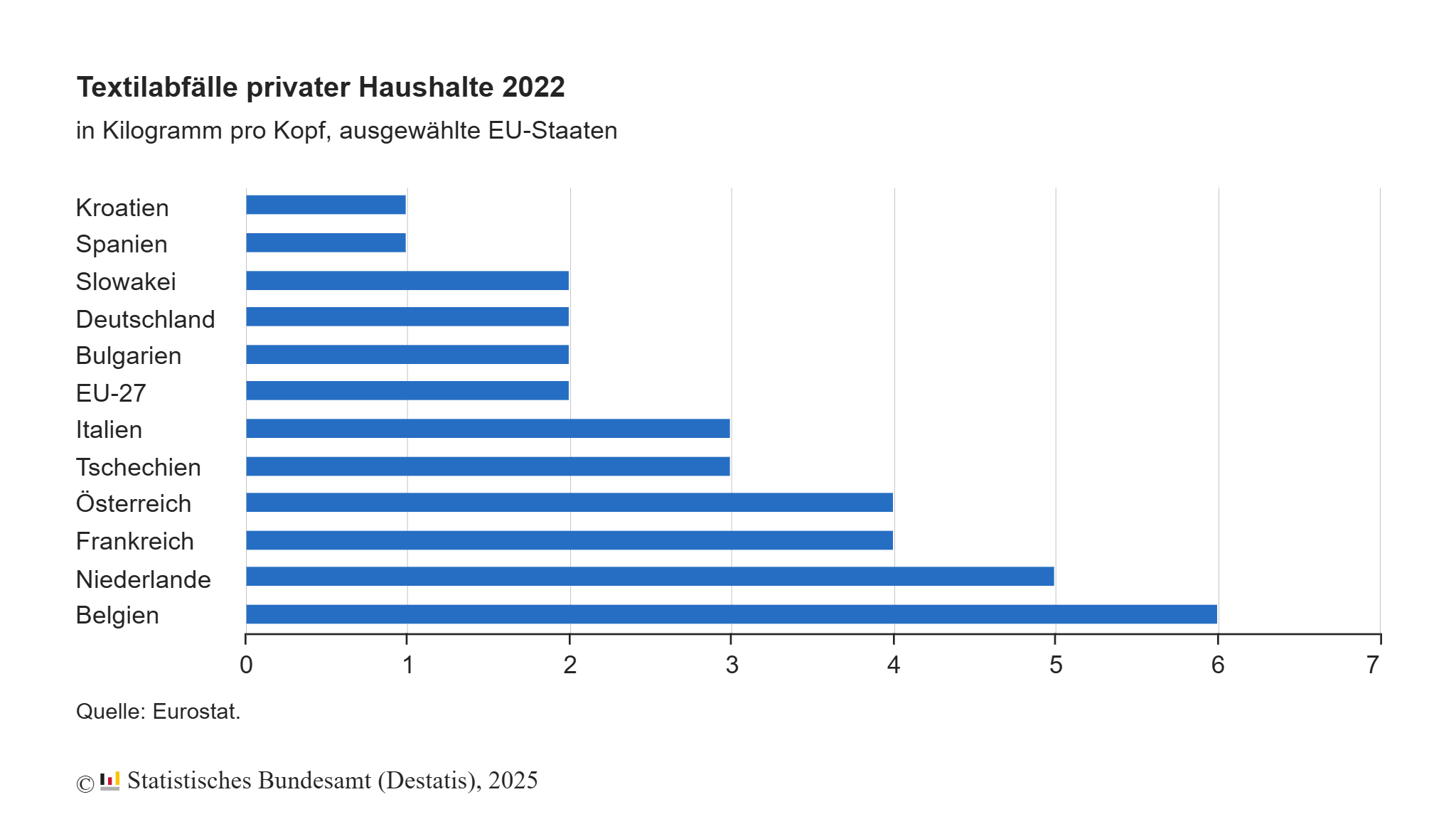According to the EU directive, textile waste must be collected and disposed of separately from the beginning of January. In 2023, 175,000 tonnes of textile waste was collected from private households. Germany was the EU average with 2 kg per capita.
Wiesbaden/Germany, January 29, 2025. Since 1 January 2025, textiles must be disposed of separately from other waste in accordance with a new EU directive. According to preliminary results, around 175,000 tonnes of textile and clothing waste was already collected from private households in Germany in 2023, mainly by public waste management authorities, as reported by the Federal Statistical Office (Destatis). Converted to the population at the end of 2023, this corresponded to around 2 kilograms per capita. Overall, this was 55% more textile and clothing waste than ten years previously: in 2013, the volume was around 112,700 tonnes. The peak value of the past ten years was in the coronavirus year 2020 with around 187,000 tonnes.
According to the EU directive, used clothing and textiles may no longer be disposed of with residual waste. In Germany, old clothes and used textiles such as towels, fabric remnants and old carpets were also previously collected separately by public waste disposal organisations, for example via used clothing containers or recycling centres.
In 2022, 910,000 tonnes of textile waste was generated by private households across the EU. In an EU comparison, figures on textile waste from private households treated by waste management are available for 2022. According to EU statistics authority Eurostat, Belgium (6 kilograms), the Netherlands (5 kilograms), France and Austria (4 kilograms each), among others, generated more textile waste per capita. In total, 910,000 tonnes of textile waste was generated by private households in the European Union (EU) in 2022. Germany accounted for 148,900 tonnes, which corresponds to 16% of EU textile waste. The amount of textile waste in the national waste statistics was higher, as this also includes some commercial or charitable collections that do not end up in a waste treatment plant.
Used clothing and used textile goods that do not end up on the second-hand market or in domestic recycling are also exported abroad. A total of around 452,000 tonnes of used clothing and other used textile goods were exported from Germany in 2023. In addition to household waste, this also includes discarded commercial goods and intermediate trade in textile waste via Germany. Compared to 2022, the export volume of used textile goods fell by 6%. The Netherlands (16%) and Poland (15%) were the most important buyers of used textile goods in 2023. Turkey, the United Arab Emirates and Belgium each accounted for 6% of the export volume.
Methodological notes:
The survey on household waste from public waste management authorities and, below this, the volume of clothing and textile waste is taken from waste statistics. The survey only includes the portion of textile and clothing waste that is collected separately and disposed of via the waste management system. This primarily relates to textiles collected from private households by public waste management organisations. Most of this separately collected clothing and textiles is channelled through sorting facilities. Used clothing and textiles that are not disposed of and collected separately but end up in the residual waste bin, for example, cannot be collected separately.
In addition to the public waste disposal authorities, non-profit organisations and private companies also collect clothing and other textiles. These waste volumes are included in the statistics, provided that data is available.
The vast majority of used textiles are probably collected via the second-hand market and private used clothing collections by commercial enterprises or charitable organisations. These are only included in the waste statistics if they are disposed of via the waste management system in Germany.
The figures in the EU waste statistics include textile waste that is channelled through waste management in Germany and the EU countries, i.e. textile waste generated in a country and treated in a waste treatment plant. The figures for clothing and textile waste from the national waste statistics are therefore higher than the EU figures for textile waste in waste management because, for example, used clothing is collected from commercial or charitable collections but is later exported to other countries, fed into the national second-hand market or charitable organisations and is therefore not treated by national waste management.
The subject of foreign trade statistics is Germany’s cross-border trade in goods with other countries. German exports of commodity code WA63090000 ‘Used textile products’ are shown.
Image source
Eurostat, Federal Statistical Office Destatis, 2025


